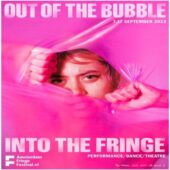Edinburgh Fringe 2016
Low Down
Camille is a solo performance by Kamila Klamut based on the life of Camille Claudel – it is a performance of heart rending intensity and beauty.
Review
Camille Claudel was a 19th century sculptor. She was also Auguste Rodin’s lover for ten years, and sister of the dramatist and poet, Paul Claudel. When she suffered an episode of mental illness after her relationship with Rodin ended, Paul Claudel had her committed to a lunatic asylum. In spite of the asylum telling the family she was well enough to leave, she stayed there until she died thirty years later.
Out of this raw material, Kamila Klamut has created a claustrophobic patriarchal nightmare. Initially seated centre stage, Klamut gives us Camille as an elderly lady to towards the end of her life and moves out from here to explore different phases of her life in fragmentary scenes. Independent and defiantly subversive, Camille creates art, is a sweary lady and enjoys a drink – forbidden territory for a woman. The piece is a wailing lamentation for the subjugation of women who stray from the permitted order.
Kamila Klamut gives an absolutely astounding performance. Her acting is intensely physical, seemingly teased out of every last sinew of her body. She manages the flitting moves between the memories and different eras of Camille’s life without needing costume changes to depict them; she becomes the younger Camille or the elderly lady simply though her physical posture and movement. There is a beautiful sequence where Klamut dresses in a dress, which is reminiscent of white clay sculpture, and, in particular, of her own sculpture, The Wave; here, she moves from a carefree celebration of art and creation to a whirling dervish spinning out of control to destruction.
The project was created during an artistic residency at the Grotowski Institute in Wroclaw. Klamut is a member of Song of the Goat and Theatre Zar. The piece was created in cooperation with Ewa Pasikowska, whose multi instrumental accompaniment unobtrusively adds to the performance.
The lighting creates monochromatic effects like old black and white photographs, life stilled and stopped. Bartosz Radziszewki’s lighting is mostly a succession of spots moving to where the action vignettes take place. When Camille moves back to her centre stage seat, the light floods down like a river of light highlighting Camille’s anguished face.
As is so often the case in the borrowed spaces of the Edinburgh Fringe, the venue suffers from noise bleed. Though this is inevitable with such tight cramming and programming, this intense performance could have done without the addition of music and drumbeats. It needs a silent, contained space.
Camille is a piece of raw intensity with a powerful performance by Klamut.


































